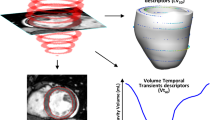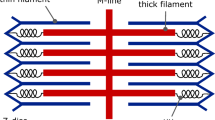Summary
An investigation was carried out on isolated cat's papillary muscle in order to study displacement effects upon the intensity and the time course of the contractile activity. Displacements occurring before or very early during a contractile cycle produce effects which can be entirely explained on the basis of the cardiac active length-tension relation. Displacements occurring later exhibit additional effects in so far as either stretches or releases induce a drop of contractile activation such that the course of the subsequent tension development is markedly below that of the same displacement applied earlier. In order to separate these effects from those based on the active length-tension correlation experiments were performed in which very short release-stretch or stretch-release operations were applied so that the muscle length was virtually the same at the beginning and at the end of the operation. The results obtained under these conditions can be summarized as follows.
The extend to which contractile tension drops after a stretch-release or a release-stretch cycle has been applied depends upon (1) the stimulus intervention interval (2) the length change performed (3) the velocity of displacement during the intervention. It is not dependent on the initial muscle length. Increasing the extracellular Ca-concentration considerably reduces the displacement effects. The results are tentatively explained by assuming an internal feedback loop between a variable of the contractile machinary and the preceding mechanism of activation.
Similar content being viewed by others
References
Abbott, B. C., Mommaerts, W. F. H. M.: A study of inotropic mechanisms in the papillary muscle preparation. J. gen. Physiol.42, 533 (1959).
Antoni, H., Jakob, R., Kaufmann, R.: Mechanische Reaktionen des Frosch- und Säugetiermyokards bei Veränderung der Aktionspotential-Dauer durch konstante Gleichstromimpulse. Pflügers Arch. ges. Physiol.300, 33 (1969).
Baker, P. F., Meves, H., Ridgway, E. B.: Phasic entry of calcium in response to depolarisation of giant axons of Loligo fortesi. J. Physiol. (Lond.)215, 22P (1971).
Beeler, G. W., Reuter, H.: Membrane calcium current in ventricular myocardial fibres. J. Physiol. (Lond.)207, 191 (1970).
Brady, A. J.: Time and displacement dependence of cardiac contractility: problems in defining the active state and force velocity relations. Fed. Proc.24, 1410 (1965).
—: Onset of contractility in cardiac muscle. J. Physiol. (Lond.)184, 560 (1966).
Brutsaert, D. L., Sonnenblick, E. H.: Force-velocity-length-time relations of the contractile elements in heart muscle of the cat. Circulat. Res.24 137 (1969).
Davies, R. E.: A molecular theory of muscle contraction: calcium-dependent contractions with hydrogen bond formation plus ATP-dependent extensions of part of the myosin-actin bridges. Nature (Lond.)199, 1078 (1963).
Ebashi, S., Endo, M.: Calcium ion and muscle contraction. Progr. biophys. molec. Biol.18, 123 (1968).
Edman, K. A. P.: The active state and the force-velocity relation in the cardiac muscle. In: Herzinsuffizienz, Pathophysiologie und Klinik, S. 133. Hrsg.: H. Reindell, J. Keul u. E. Doll: Stuttgart: G. Thieme 1968.
— Nilsson, E.: The dynamics of the inotropic change produced by altered pacing of rabbit papillary muscle. Acta physiol. scand.76, 230 (1969).
Fenn, W. O.: A quantitative comparison between the energy liberated and the work performed by the isolated sartorius of the frog. J. Physiol. (Lond.)58, 175 (1923).
Goodall, M. C.: Kinetics of muscular contraction. Yale J. Biol. Med.39, 224 (1957).
Hill, A. V.: The heat of shortening and the dynamic constants of muscle. Proc. roy. Soc. B126, 136 (1938).
— The abrupt transition from rest to activity in muscle. Proc. roy. Soc. B130, 399 (1949).
— The effect of tension in prolonging the active state in a twitch. Proc. roy. Soc. B159, 589 (1964).
Huxley, A. F.: Muscle structure and theories of contraction. Progr. Biophys.7, 255 (1957).
Jewell, B. R., Wilkie, D. R.: The mechanical properties of relaxing muscle. J. Physiol. (Lond.)152, 30 (1960).
Julian, F. J.: Activation in a skeletal muscle contraction model with modification for insect fibrillar muscle. Biophys. J.9, 547 (1969).
Kaufmann, R., Lab, M. J., Hennekes, R., Krause, H.: Feedback interaction of mechanical and electrical events in the isolated mammalian ventricular myocardium. Pflügers Arch.324, 100 (1971).
Kohlhardt, M., Bauer, B., Krause, H., Fleckenstein, A.: New selective inhibitors of the transmembrane Ca conductivity in mammalian myocardial fibres. Studies with the voltage clamp technique Experientia (in press) (1972).
Langer, G. A.: Ion fluxes in cardiac excitation and contraction and their relation to myocardial contractility. Physiol. Rev.48, 708 (1968).
Mommaerts, W. F. H. M.: Energetics of muscular contraction. Physiol. Rev.49, 427 (1969).
— What is the Fenn-Effect? Naturwissenschaften57, 326 (1970).
Ochi, R., Trautwein, W.: The dependence of cardiac contraction on depolarisation and slow inward current. Pflügers Arch.323, 187 (1971).
Podolsky, R. J., Nolan, A. C., Zaveler, S. A.: Cross-bridge properties derived from muscle isotonic velocity transients. Proc. nat. Acad. Sci. (Wash.)64, 504 (1969).
Pringle, J. W. S.: The contractile mechanism of insect fibrillar muscle. Progr. biophys. molec. Biol.17, 3 (1967).
Sonnenblick, E. H.: Instantaneous force-velocity-length determinants in the contraction of heart muscle. Circulat. Res.16, 441 (1965).
Wood, E. H., Heppner, R. L., Weidmann, S.: Inotropic effects of electric currents. Circulat. Res.24, 410 (1969).
Author information
Authors and Affiliations
Additional information
This investigation was supported by the Deutsche Forschungsgemeinschaft (grant Ka 287, 1+3).
Rights and permissions
About this article
Cite this article
Kaufmann, R.L., Bayer, R.M. & Harnasch, C. Autoregulation of contractility in the myocardial cell. Pflugers Arch. 332, 96–116 (1972). https://doi.org/10.1007/BF00589087
Received:
Issue Date:
DOI: https://doi.org/10.1007/BF00589087




